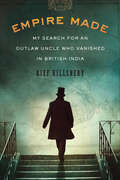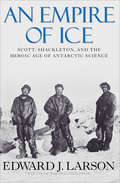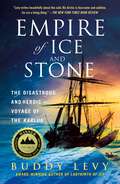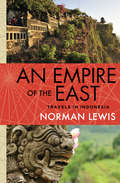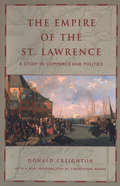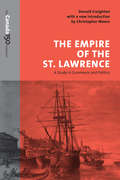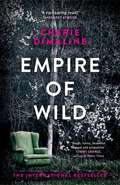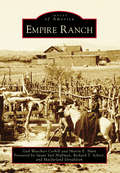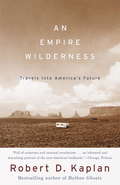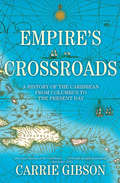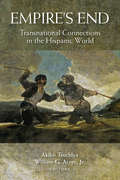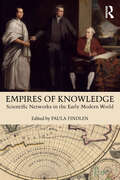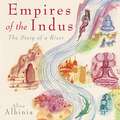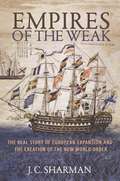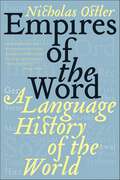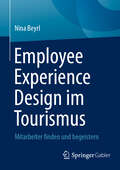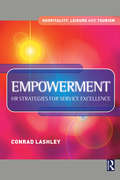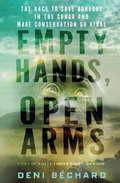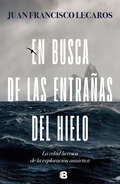- Table View
- List View
Empire Made: My Search for an Outlaw Uncle Who Vanished in British India
by Kief HillsberyLost in time for generations, the story of a 19th-century English gentleman in British India—a family mystery of love found and loyalties abandoned, finally brought to light In 1841, twenty-year-old Nigel Halleck set out for Calcutta as a clerk in the East India Company. He went on to serve in the colonial administration for eight years before abruptly leaving the company under a cloud and disappearing in the mountain kingdom of Nepal, never to be heard from again. While most traces of his life were destroyed in the bombing of his hometown during World War II, Nigel was never quite forgotten—the myth of the man who headed East would reverberate through generations of his family. Kief Hillsbery, Nigel&’s nephew many times removed, embarked on his own expedition, spending decades researching and traveling through India, Pakistan, Afghanistan, and Nepal in the footsteps of his long-lost relation. In uncovering the remarkable story of Nigel&’s life, Hillsbery beautifully renders a moment in time when the arms of the British Empire extended around the world. Both a powerful history and a personal journey, Empire Made weaves together a clash of civilizations, the quest to discover one&’s own identity, and the moving tale of one man against an empire.
An Empire of Ice: Scott, Shackleton, and the Heroic Age of Antarctic Science (Playaway Adult Nonfiction Ser.)
by Edward J. LarsonA Pulitzer Prize–winning author examines South Pole expeditions, &“wrapping the science in plenty of dangerous drama to keep readers engaged&” (Booklist). An Empire of Ice presents a fascinating new take on Antarctic exploration—placing the famed voyages of Norwegian explorer Roald Amundsen, his British rivals Robert Scott and Ernest Shackleton, and others in a larger scientific, social, and geopolitical context. Recounting the Antarctic expeditions of the early twentieth century, the author reveals the British efforts for what they actually were: massive scientific enterprises in which reaching the South Pole was but a spectacular sideshow. By focusing on the larger purpose of these legendary adventures, Edward J. Larson deepens our appreciation of the explorers&’ achievements, shares little-known stories, and shows what the Heroic Age of Antarctic discovery was really about. &“Rather than recounting the story of the race to the pole chronologically, Larson concentrates on various scientific disciplines (like meteorology, glaciology and paleontology) and elucidates the advances made by the polar explorers . . . Covers a lot of ground—science, politics, history, adventure.&” —The New York Times Book Review
Empire of Ice and Stone: The Disastrous and Heroic Voyage of the Karluk
by Buddy LevyNational Outdoor Book Awards WinnerThe true, harrowing story of the ill-fated 1913 Canadian Arctic Expedition and the two men who came to define it.In the summer of 1913, the wooden-hulled brigantine Karluk departed Canada for the Arctic Ocean. At the helm was Captain Bob Bartlett, considered the world’s greatest living ice navigator. The expedition’s visionary leader was a flamboyant impresario named Vilhjalmur Stefansson hungry for fame.Just six weeks after the Karluk departed, giant ice floes closed in around her. As the ship became icebound, Stefansson disembarked with five companions and struck out on what he claimed was a 10-day caribou hunting trip. Most on board would never see him again.Twenty-two men and an Inuit woman with two small daughters now stood on a mile-square ice floe, their ship and their original leader gone. Under Bartlett’s leadership they built make-shift shelters, surviving the freezing darkness of Polar night. Captain Bartlett now made a difficult and courageous decision. He would take one of the young Inuit hunters and attempt a 1000-mile journey to save the shipwrecked survivors. It was their only hope.Set against the backdrop of the Titanic disaster and World War I, filled with heroism, tragedy, and scientific discovery, Buddy Levy's Empire of Ice and Stone tells the story of two men and two distinctively different brands of leadership—one selfless, one self-serving—and how they would forever be bound by one of the most audacious and disastrous expeditions in polar history, considered the last great voyage of the Heroic Age of Discovery.
An Empire of the East: Travels in Indonesia
by Norman LewisFrom Sumatra to East Timor and beyond, An Empire of the East is a fascinating look at a rapidly changing island nationIn An Empire of the East, renowned travel essayist Norman Lewis takes readers to Indonesia, where some thirteen thousand islands in the South Pacific are each colored with their own unique cultures and histories. With more than three hundred ethnic groups speaking two hundred fifty languages, the warmth and generosity of the island people is matched only by the country&’s complicated political and social landscape. Lewis&’s account tells of a country whose remarkable cultures—as well as its flora and fauna—are increasingly shaped by the waves of modernity and global tourism.
The Empire of the St. Lawrence: A Study in Commerce and Politics
by Donald CreightonOriginally published in 1937 as "The Commercial Empire of the St. Lawrence, 1760 - 1850" and re-issued in its present form in 1956, Donald Creighton's study of the St. Lawrence became an essential text in Canadian history courses. This, his first book, helped establish Creighton as the foremost English Canadian historian of his generation. In it, he examines the trading system that developed along the St. Lawrence River and he argues that the exploitation of key staple products by colonial merchants along the St. Lawrence River system was key to Canada's economic and national development. Creighton tells the story of the St. Lawrence empire largely from the perspective of these Canadian merchants, who, above all others, struggled to win the territorial empire of the St. Lawrence and to establish the Canadian commercial state. Christopher H. Moore, historian and Governor General Award winner, has written a new introduction to this classic text.
The Empire of the St. Lawrence: A Study in Commerce and Politics
by Christopher Moore Donald CreightonOriginally published in 1937 as "The Commercial Empire of the St. Lawrence, 1760-1850" and re-issued in its present form in 1956, Donald Creighton's study of the St. Lawrence became an essential text in Canadian history courses. This, his first book, helped establish Creighton as the foremost English Canadian historian of his generation. In it, he examines the trading system that developed along the St. Lawrence River and he argues that the exploitation of key staple products by colonial merchants along the St. Lawrence River system was key to Canada's economic and national development. Creighton tells the story of the St. Lawrence empire largely from the perspective of these Canadian merchants, who, above all others, struggled to win the territorial empire of the St. Lawrence and to establish the Canadian commercial state. Christopher H. Moore, historian and Governor General Award winner, has written a new introduction to this classic text.
Empire of Wild: A Novel
by Cherie DimalineA #1 INTERNATIONAL BESTSELLEROne of the most anticipated books of the summer for Time, Harper's Bazaar, Bustle and Publishers Weekly'Deftly written, gripping and informative. Empire of Wild is a rip-roaring read!' Margaret Atwood'Empire of Wild is doing everything I love in a contemporary novel and more. It is tough, funny, beautiful, honest and propulsive' Tommy Orange, author of There There 'Dimaline turns an old story into something newly haunting and resonant' New York Times'Close, tight, stark, beautiful - rich where richness is warranted, but spare where want and sorrow have sharpened every word. Dimaline has crafted something both current and timeless' NPR'Revelatory... Gritty and engaging, this story of a woman and her missing husband is one of candor, wit and tradition'Ms. Magazine Broken-hearted Joan has been searching for her husband, Victor, for almost a year - ever since he went missing on the night they had their first serious argument. One hung-over morning in a Walmart parking lot in a little town near Georgian Bay, she is drawn to a revival tent where the local Métis have been flocking to hear a charismatic preacher. By the time she staggers into the tent the service is over, but as she is about to leave, she hears an unmistakable voice.She turns, and there is Victor. Only he insists he is not Victor, but the Reverend Eugene Wolff, on a mission to bring his people to Jesus.With only two allies - her Johnny-Cash-loving, 12-year-old nephew Zeus, and Ajean, a foul-mouthed euchre shark with deep knowledge of the old Métis ways - Joan sets out to remind the Reverend Wolff of who he really is. If he really is Victor, his life and the life of everyone she loves, depends upon her success.Inspired by traditional Métis legends, Cherie Dimaline has created a propulsive, stunning and sensuous novel.
Empire Ranch
by Gail Waechter Corkill Sharon E. HuntThe Empire Ranch sits in the heart of the rolling grasslands and oak-studded foothills of Las Cienegas National Conservation Area in southeastern Arizona. Its remarkable history and the ranching way of life are told through the stories of the men, women, and children of the Empire, most notably the Vail, Boice, and Donaldson families. Walter L. Vail and Herbert R. Hislop purchased the Empire Ranch homestead for $2,000 in 1876. The Vail family operated the ranch until 1928, turning it into a cattle ranching empire. From 1928 to 1975, the well-respected Boice family ran a vibrant Hereford operation on the Empire. The Donaldson family used innovative range management methods to continue the ranching legacy from 1975 to 2009. Today, the ranch, under the management of the Bureau of Land Management, remains one of the oldest continuously working cattle ranches in the region.
An Empire Wilderness
by Robert D. KaplanHaving reported on some of the world's most violent, least understood regions in his bestsellers Balkan Ghosts and The Ends of the Earth, Robert Kaplan now returns to his native land, the United States of America. Traveling, like Tocqueville and John Gunther before him, through a political and cultural landscape in transition, Kaplan reveals a nation shedding a familiar identity as it assumes a radically new one. An Empire Wilderness opens in Fort Leavenworth, Kansas, where the first white settlers moved into Indian country and where Manifest Destiny was born. In a world whose future conflicts can barely be imagined, it is also the place where the army trains its men to fight the next war. "A nostalgic view of the United States is deliberately cultivated here," Kaplan writes, "as if to bind the uncertain future to a reliable past." From Fort Leavenworth, Kaplan travels west to the great cities of the heartland--to St. Louis, once a glorious shipping center expected to outshine imperial Rome and now touted, with its desolate inner city and miles of suburban gated communities, as "the most average American city." Kaplan continues west to Omaha; down through California; north from Mexico, across Arizona, New Mexico, and Texas; up to Montana and Canada, and back through Oregon. He visits Mexican border settlements and dust-blown county sheriffs' offices, Indian reservations and nuclear bomb plants, cattle ranches in the Oklahoma Panhandle, glacier-mantled forests in the Pacific Northwest, swanky postsuburban sprawls and grim bus terminals, and comes, at last, to the great battlefield at Vicksburg, Mississippi, where an earlier generation of Americans gave their lives for their vision of an American future. But what, if anything, he asks, will today's Americans fight and die for? At Vicksburg Kaplan contemplates the new America through which he has just traveled--an America of sharply polarized communities that draws its population from pools of talent far beyond its borders; an America where the distance between winners and losers grows exponentially as corporations assume gov-ernment functions and the wealthy find themselves more closely linked to their business associates in India and China than to their poorer neighbors a few miles away; an America where old loyalties and allegiances are vanishing and new ones are only beginning to emerge. The new America he found is in the pages of this book. Kaplan gives a precise and chilling vision of how the most successful nation the world has ever known is entering the final, and highly uncertain, phase of its history.
Empire's Crossroads: A History of the Caribbean from Columbus to the Present Day
by Carrie Gibson“Ever since Christopher Columbus stepped off the Santa Maria onto what is today San Salvador, in the Bahamas, and announced that he had arrived in the Orient, the Caribbean has been a stage for projected fantasies and competition between world powers. In “Empire’s Crossroads”, British American historian Carrie Gibson traces the story of this coveted area from the northern rim of South America up to Cuba, and from discovery through colonialism to today, offering a vivid, panoramic view of this complex region and its rich, important history. After that fateful landing in 1492, the British, French, Spanish, Portuguese, Dutch, Danish, and even the Swedes, Scots, and Germans sought their fortunes in the islands for the next two centuries. Some failed spectacularly: a poorly executed settlement in Panama led the Scots to lose their own independence to England. The Spaniards were the first to find prosperity, in Mexico but also along the islands. In Hispaniola, Cuba, and Puerto Rico, they built grandiose cathedrals and extracted shipfuls of gold and silver, which English, French, and Dutch pirates were happy to seize. But precious metals weren’t a sustainable export the colonizers needed something that was, and they would need hordes of slaves to cultivate it. The Caribbean’s first cash crop, one indigenous to the New World, was tobacco, and it, along with sugar, spurred expensive new addictions back in Europe. Gibson argues that immaterial exports were just as important. No other region of the world has experienced such a vibrant mixing of cultures, religions, and peoples Africans, Europeans, Asians, and Amerindians created amazingly dynamic Creole societies that complicated traditional ideas about class and race. By the end of the eighteenth century, seventy thousand free blacks and mulattos lived in the British islands alone, and it was in the Caribbean that the world’s only successful slave revolt took place sparking the meteoric rise of Napoleon’s black counterpart, Toussaint L’Ouverture, and the Haitian Revolution. The Caribbean island of St. Eustatius had been the first to recognize the United States as a nation, but the Americans were soon vying for their own imperial stronghold in the West Indies, attempting to control Cuba and backing influential corporations, most notably United Fruit. In the twentieth century, most of the islands broke from the imperial traditions that had lorded over them for four centuries: this would be the explosive age of decolonization and banana republics,” of racial riots and négritude, of Cold War politics and tourist crowds. At every step of her expansive story, Gibson wields fascinating detail to combat the myths that have romanticized this region as one of uniform white sand beaches where the palm trees always sway. Evocatively written and featuring a whole cast of cosmopolitan characters, “Empire’s Crossroads” reinterprets five centuries of history that have been underappreciated for far too long.
Empire's End: Transnational Connections in the Hispanic World
by Akiko Tsuchiya William G. Acree Jr.The fall of the Spanish Empire: that period in the nineteenth century when it lost its colonies in Spanish America and the Philippines. How did it happen? What did the process of the "end of empire" look like? Empire's End considers the nation's imperial legacy beyond this period, all the way up to the present moment. In addition to scrutinizing the political, economic, and social implications of this "end," these chapters emphasize the cultural impact of this process through an analysis of a wide range of representations—literature, literary histories, periodical publications, scientific texts, national symbols, museums, architectural monuments, and tourist routes—that formed the basis of transnational connections and exchange. The book breaks new ground by addressing the ramifications of Spain's imperial project in relation to its former colonies, not only in Spanish America, but also in North Africa and the Philippines, thus generating new insights into the circuits of cultural exchange that link these four geographical areas that are rarely considered together.Empire's End showcases the work of scholars of literature, cultural studies, and history, centering on four interrelated issues crucial to understanding the end of the Spanish empire: the mappings of the Hispanic Atlantic, race, human rights, and the legacies of empire.
Empire's End: Transnational Connections in the Hispanic World
by Akiko Tsuchiya William G. Acree Jr.The fall of the Spanish Empire: that period in the nineteenth century when it lost its colonies in Spanish America and the Philippines. How did it happen? What did the process of the "end of empire" look like? Empire's End considers the nation's imperial legacy beyond this period, all the way up to the present moment. In addition to scrutinizing the political, economic, and social implications of this "end," these chapters emphasize the cultural impact of this process through an analysis of a wide range of representations—literature, literary histories, periodical publications, scientific texts, national symbols, museums, architectural monuments, and tourist routes—that formed the basis of transnational connections and exchange. The book breaks new ground by addressing the ramifications of Spain's imperial project in relation to its former colonies, not only in Spanish America, but also in North Africa and the Philippines, thus generating new insights into the circuits of cultural exchange that link these four geographical areas that are rarely considered together.Empire's End showcases the work of scholars of literature, cultural studies, and history, centering on four interrelated issues crucial to understanding the end of the Spanish empire: the mappings of the Hispanic Atlantic, race, human rights, and the legacies of empire.
Empires Lost and Won: The Spanish Heritage in the Southwest
by Albert MarrinA vivid examination of the Spanish influence in the American Southwest by a Boston Globe/Horn Book Award winner. Albert Marrin, prize-winning historian, presents the sweeping tale of the Spanish conquest of the American Southwest. Early in 1540, Francisco Vasquez de Coronado left Mexico City to claim the fabled cities that lay to the north. The cities were really Pueblo Indian villages, but by 1610, Santa Fe was firmly established as the capital of New Mexico. In the nineteenth century Texans voted for independence from Mexico, the United States declared war, and in the end Mexico lost its entire northern empire. Marrin sets this powerful tale firmly in its period and place, making dramatically clear the importance of the unfolding events.
Empires of Knowledge: Scientific Networks in the Early Modern World
by Paula FindlenEmpires of Knowledge charts the emergence of different kinds of scientific networks – local and long-distance, informal and institutional, religious and secular – as one of the important phenomena of the early modern world. It seeks to answer questions about what role these networks played in making knowledge, how information traveled, how it was transformed by travel, and who the brokers of this world were. Bringing together an international group of historians of science and medicine, this book looks at the changing relationship between knowledge and community in the early modern period through case studies connecting Europe, Asia, the Ottoman Empire, and the Americas. It explores a landscape of understanding (and misunderstanding) nature through examinations of well-known intelligencers such as overseas missions, trading companies, and empires while incorporating more recent scholarship on the many less prominent go-betweens, such as translators and local experts, which made these networks of knowledge vibrant and truly global institutions. Empires of Knowledge is the perfect introduction to the global history of early modern science and medicine.
Empires of the Indus
by Alice Albinia10th anniversary edition with new PrefaceOne of the largest rivers in the world, the Indus rises in the Tibetan mountains, flows west across northern India and south through Pakistan. For millennia it has been worshipped as a god; for centuries used as a tool of imperial expansion; today it is the cement of Pakistans fractious union. Five thousand years ago, a string of sophisticated cities grew and traded on its banks. In the ruins of these elaborate metropolises, Sanskrit-speaking nomads explored the river, extolling its virtues in Indias most ancient text, the Rig-Veda. During the past two thousand years a series of invaders - Alexander the Great, Afghan Sultans, the British Raj - made conquering the Indus valley their quixotic mission. For the people of the river, meanwhile, the Indus valley became a nodal point on the Silk Road, a centre of Sufi pilgrimage and the birthplace of Sikhism. Empires of the Indus follows the river upstream and back in time, taking the reader on a voyage through two thousand miles of geography and more than five millennia of history redolent with contemporary importance.
Empires of the Weak: The Real Story of European Expansion and the Creation of the New World Order
by Jason SharmanHow the rise of the West was a temporary exception to the predominant world orderWhat accounts for the rise of the state, the creation of the first global system, and the dominance of the West? The conventional answer asserts that superior technology, tactics, and institutions forged by Darwinian military competition gave Europeans a decisive advantage in war over other civilizations from 1500 onward. In contrast, Empires of the Weak argues that Europeans actually had no general military superiority in the early modern era. J. C. Sharman shows instead that European expansion from the late fifteenth to the late eighteenth centuries is better explained by deference to strong Asian and African polities, disease in the Americas, and maritime supremacy earned by default because local land-oriented polities were largely indifferent to war and trade at sea.Europeans were overawed by the mighty Eastern empires of the day, which pioneered key military innovations and were the greatest early modern conquerors. Against the view that the Europeans won for all time, Sharman contends that the imperialism of the late nineteenth and early twentieth centuries was a relatively transient and anomalous development in world politics that concluded with Western losses in various insurgencies. If the twenty-first century is to be dominated by non-Western powers like China, this represents a return to the norm for the modern era.Bringing a revisionist perspective to the idea that Europe ruled the world due to military dominance, Empires of the Weak demonstrates that the rise of the West was an exception in the prevailing world order.
Empires of the Word: A Language History of the World
by Nicholas OstlerNicholas Ostler's Empires of the Word is the first history of the world's great tongues, gloriously celebrating the wonder of words that binds communities together and makes possible both the living of a common history and the telling of it. From the uncanny resilience of Chinese through twenty centuries of invasions to the engaging self-regard of Greek and to the struggles that gave birth to the languages of modern Europe, these epic achievements and more are brilliantly explored, as are the fascinating failures of once "universal" languages. A splendid, authoritative, and remarkable work, it demonstrates how the language history of the world eloquently reveals the real character of our planet's diverse peoples and prepares us for a linguistic future full of surprises.
Employability and Skills Handbook for Tourism, Hospitality and Events Students
by Miriam FirthThis handbook provides students with an essential understanding of the skills and knowledge needed to work in the tourism, hospitality and events industries. It offers reflective, reflexive and critical analysis on personal, academic and professional development. Not only looking at how to develop the skills, attributes and prospects for employment in these competitive industries, this handbook also focuses on what the employers in tourism, hospitality and events sectors require of graduate employees. Highly illustrated, the chapters contain think points and activities, and case studies are integrated throughout offering first hand advice from both employer and graduate perspectives. The first book to focus on skills and employability in tourism, hospitality and events, this is a must read for all students studying these fields.
Employee Experience Design im Tourismus: Mitarbeiter finden und begeistern
by Nina BeyrlDieses Buch zeigt auf, wie eine durchdachte und strategisch ausgerichtete Employee Experience im Tourismussektor zu einem entscheidenden Differenzierungsmerkmal im Wettbewerb wird. Durch eine Mischung aus praxisnahen Beispielen und fundierter Theorie bietet dieses Werk einen Leitfaden für die erfolgreiche Implementierung von Employee Experience Design in Ihrem Unternehmen. Es lädt Unternehmer, Führungskräfte und Personalverantwortliche dazu ein, Employee Experience als integralen Bestandteil der Unternehmensstrategie zu begreifen, der maßgeblich zum langfristigen Erfolg beiträgt. Employee Experience Design geht über traditionelle Personalmanagementansätze hinaus. Es erfordert ein tiefes Verständnis für die Bedürfnisse, Erwartungen und Motivationen Ihres Teams sowie eine kontinuierliche Anpassung der Arbeitsumgebung, Prozesse und Unternehmenskultur an die sich wandelnden Anforderungen einer immer diverser werdenden Belegschaft. Es gilt individuell lebensphasenorientiert, intergenerational und international zu denken. Das Buch richtet sich an Führungskräfte, die die Zukunft ihrer Organisation aktiv gestalten wollen.
Employees Must Wash Hands: A Bathroom Reader in Pictures
by Carter HasegawaFinally, photographic proof of what’s behind the public bathroom door.Must Wash Hands, a collection of 120 artistic photographs, offers readers a peek into the private space of the public bathroom-that unspoken and indecent yet communal and necessary space that we enter and exit every day without a second glance.With camera in hand, Carter Hasegawa travels the public bathrooms of Boston, New York, Seattle, Las Vegas, Honolulu, Indianapolis, and other American cities, snapping photos down urinals and documenting graffitied walls and wet, toilet paper-plastered floors. Photos are arranged "chronologically” as a virtual public restroom walkthrough for the reader, and they highlight unsavory and savory bathroom elements you otherwise may not have noticed-ice cubes down a urinal, unconventional "Employees Must Wash Hands” signs, interesting tile details, or a jar of baby food on the floor. These wry but intimate photos are interspersed with popular bathroom trivia, illegally overheard bathroom conversations, half-serious comments on "proper” bathroom etiquette, and seriously real anecdotes.For fans of offbeat photography and humor books such as Awkward Family Photos, People of Walmart, and Regretsy, Must Wash Hands transforms the crude and disgusting into something more compelling and beautiful, prompting the viewer to pause, admire, laugh, and connect.
Emporia (Images of America)
by Steven F. Hanschu Darla Hodges MalleinEstablished in February 1857, Emporia's founding fathers named their new business venture Emporia after a flourishing market center in Ancient Carthage. Located in the east-central part of Kansas, Emporia is known as the "Front Porch to the Flint Hills." William Allen White, publisher and editor of the Emporia Gazette, brought national attention to Emporia in the early 1900s. Known for his fiery political essays, White became an advisor to many US presidents, five of whom visited his home, Red Rocks. Emporia is home to Emporia State University, the state's first normal school, founded in 1863. Located on the university campus are the National Teachers Hall of Fame and the Memorial to Fallen Educators, honoring those who lost their lives teaching and working in America's schools. Honoring fallen heroes is a long-standing tradition in Emporia, as it is also the founding city of Veterans Day.
Empowerment: Hr Strategies For Service Excellence (Hospitality, Leisure And Tourism Ser.)
by Conrad Lashley'Empowerment: HR strategies for service excellence' shows managers and students the importance of empowerment as part of human resource strategy. It provides a critical perspective of this established vital management technique, identifying factors that will lead to a win: win situation for all concerned. When successfully incorporated as part of HR strategy, empowerment can:* enable organizations to gain commercial and competitive advantage* become more flexible* improve employee commitment* use the skills of individual employees to best advantage and enhance personal capabilities.'Empowerment: HR strategies for service excellence' uses case studies from companies such as McDonalds, TGI Fridays and Harvester Restaurants to build a picture of empowerment of service employees in context, illustrating how different forms of empowerment are employed and different working arrangements are practiced.
Empty Hands, Open Arms: The Race to Save Bonobos in the Congo and Make Conservation Go Viral
by Deni Ellis Béchard&“Absorbing . . . Béchard&’s masterful, adventure-driven reporting delivers an inspiring account of an all-too-rare ecological success story.&” —Booklist Bonobos have captured the public imagination, due not least to their famously active sex lives. Less well known is the fact that these great apes don&’t kill their own kind, and that they share nearly 99% of our DNA. Their approach to building peaceful coalitions and sharing resources has much to teach us, particularly at a time when our violent ways have pushed them to the brink of extinction. Animated by a desire to understand bonobos and learn how to save them, Deni Ellis Béchard traveled into the Congo. Empty Hands, Open Arms is the account of this journey. Along the way, we see how partnerships between Congolese and Westerners, with few resources but a common purpose and respect for indigenous knowledge, have resulted in the protection of vast swaths of the rainforest. And we discover how small solutions—found through openness, humility, and the principle that poverty does not equal ignorance—are often most effective in tackling our biggest challenges. Combining elements of travelogue, journalism, and natural history, this incomparably rich book takes the reader not only deep into the Congo, but also into our past and future, revealing new ways to save the environment and ourselves. &“Riveting [and] surprisingly uplifting.&” —David Suzuki, author of The Sacred Balance &“The embodiment of the type of reporting that we dream of reading, but all too rarely encounter—intelligent, engaged, and above all, astonishingly perceptive.&” —Dinaw Mengestu, author of The Beautiful Things That Heaven Bears Also published as Of Bonobos and Men.
En busca de las entrañas del hielo
by Juan Francisco LecarosUna narración trepidante de las exploraciones a la Antártica durante el siglo XX. Frío glacial. Meses de oscuridad absoluta. Mil tonalidades del blanco. Bajas probabilidades de sobrevivencia. ¿Qué motivó a hombres con sus vidas resueltas a embarcarse en viajes donde se arriesgaban a morir congelados o devorados por bestias desconocidas? En busca de las entrañas del hielo. La edad heroica de la exploración antártica contesta esta pregunta a través de la narración de las principales exploraciones del siglo XX, en el que nombres como el de Ernest Shackleton, Fridtjof Nansen e, incluso, el mítico Piloto Pardo, se convirtieron en leyendas y protagonistas de las páginas más gloriosas de las exploraciones al continente blanco. Juan Francisco Lecaros, conocedor de los vientos salvajes de la Antártica, reconstruye con la precisión de una brújula y el detalle del mejor de los mapas, la historia de este territorio y de las campañas que nos han permitido conocerlo. Este libro, además de funcionar como retrato de una época, es un homenaje a la curiosidad y la tenacidad de aquellos hombres que agrandaron el mundo. Pero, sobre todo, es un texto de no ficción que se lee como la mejor de las novelas de aventuras.
En Cyclo Pedia: Everything you need to know about cycling, from the essential to the obscure
by Johan TellIn En Cyclo Pedia Johan Tell - award-winning Swedish writer and cycling obsessive - uncovers the very soul of cycling, exploring and explaining the many and varied stories that form the basis of cycling culture. Beautifully illustrated, with hundreds of entries ranging from Tour de France stages to illegal Alley Cat races, and cult heroes to cycling slang, Tell provides a personal insight into this complex world that only a cycling junkie can. From a pilgrimage to the Bianchi factory in Milan to scouring the streets of New York for the origins of the fixie, via the bicycle cafés of Barcelona and the cobblestones of Flanders, En Cyclo Pedia is a complete A to Z guide to the unique, indescribable character of global bike culture.Entries include:- Alley Cat Race- Bianchi- BMX- Brooks- Cafés- Campagnolo- Carbon Fibre- Drag- Environment- Films- Fixie- Grand Tours- Hand-built- Hipster- Lycra- Mountains- Nutrition- Oudenaarde- Paris-Roubaix- Quicksilver- Rouleur- Scalatore- Shaved Legs- Style- Tattoos- Ultracycling- Velodrome- XC- Zedler...and many more
